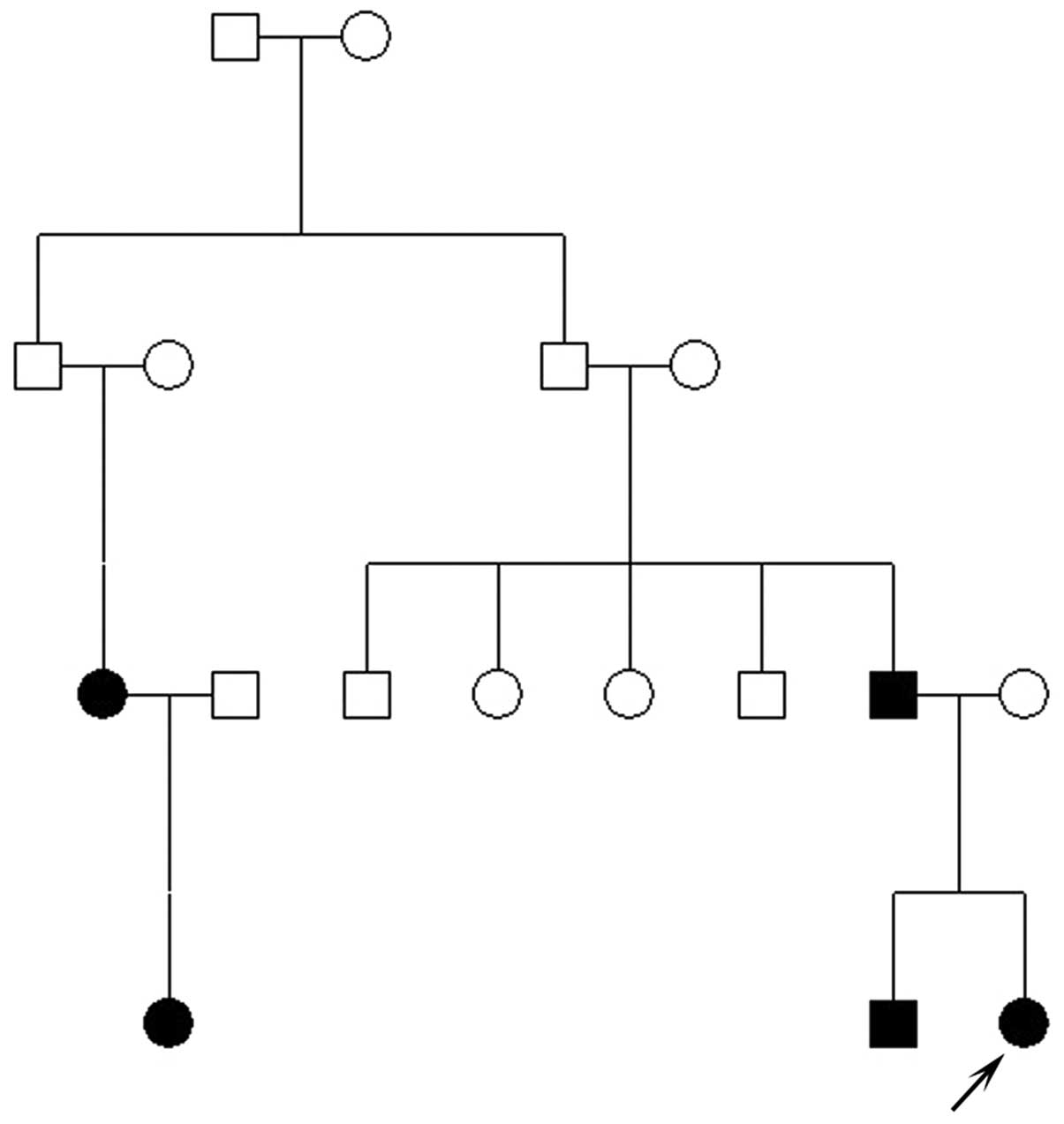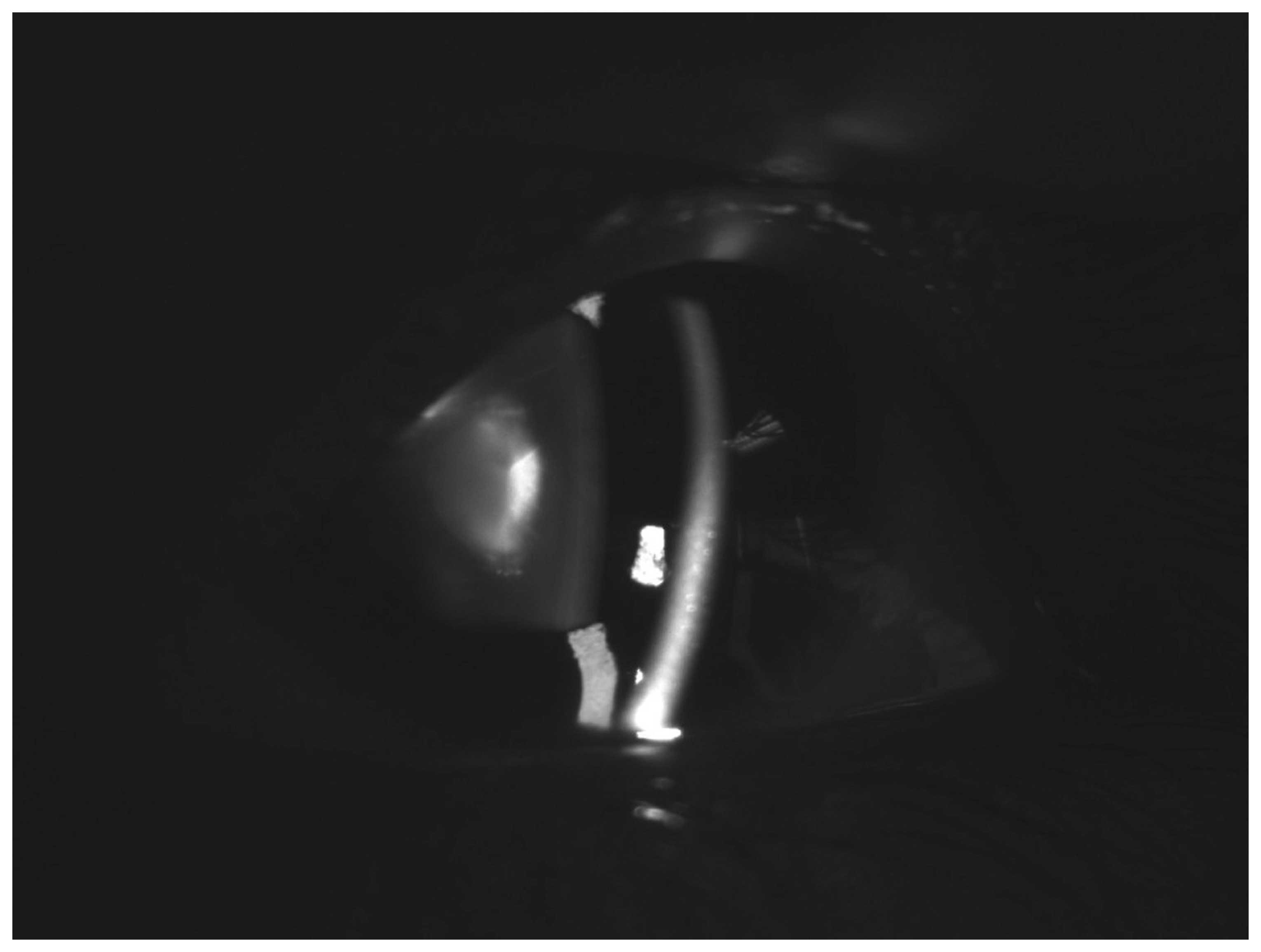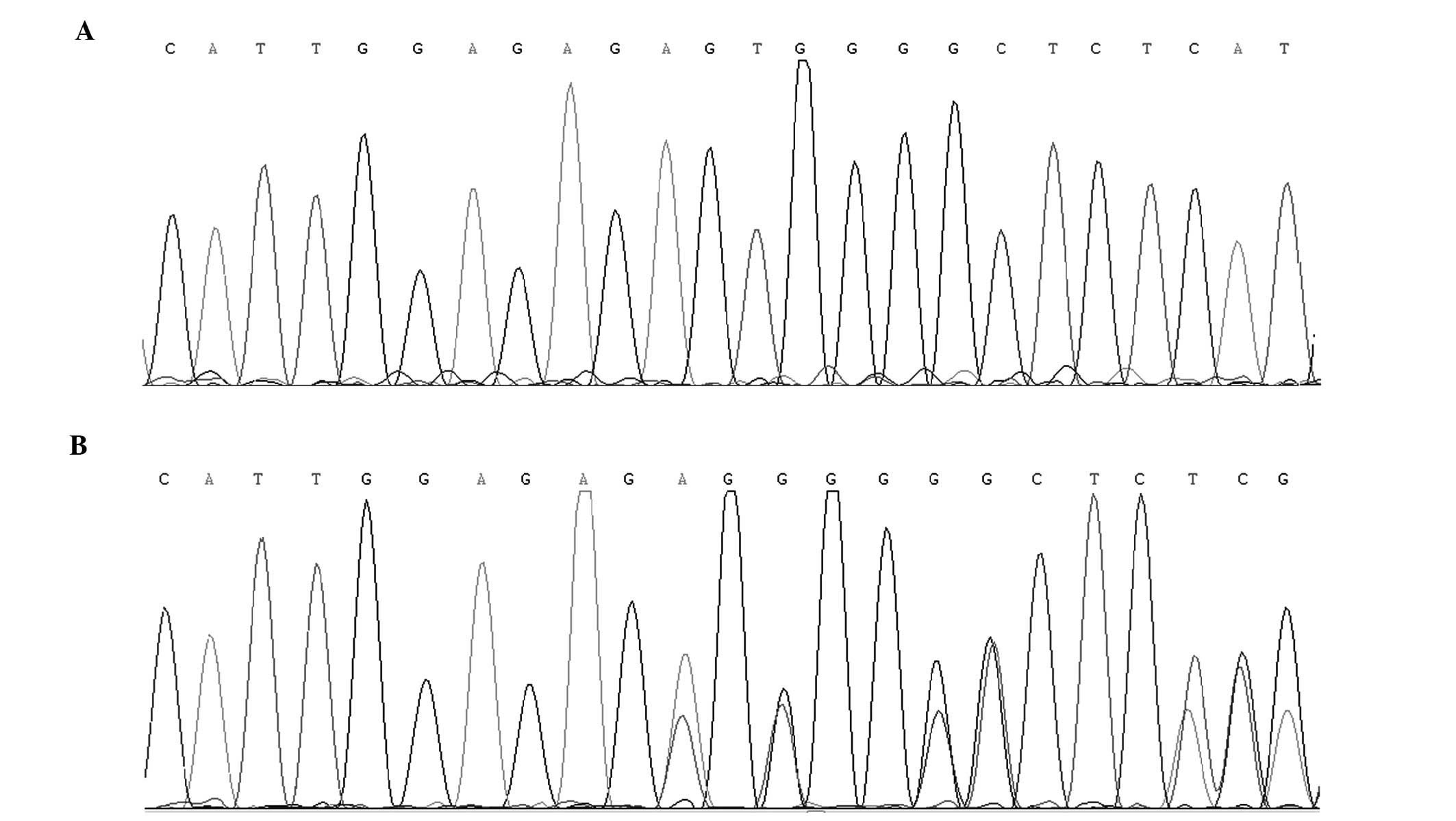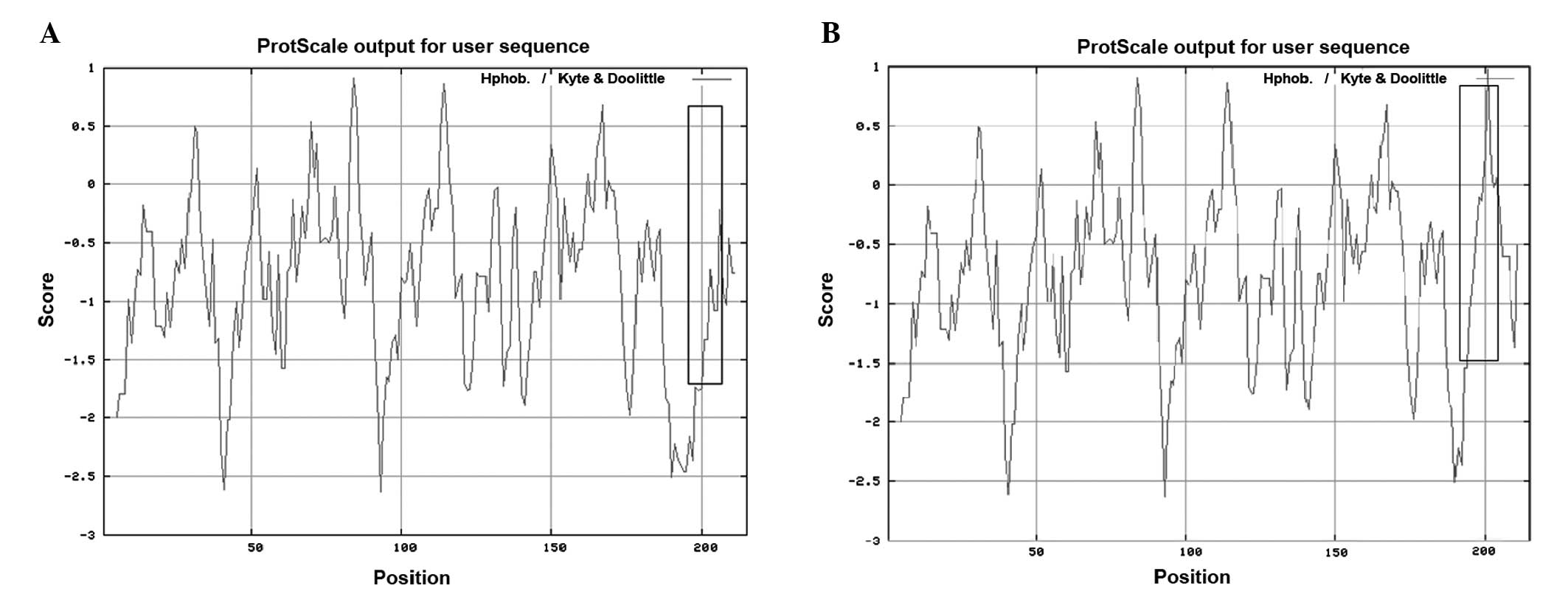Congenital cataracts due to a novel 2‑bp deletion in CRYBA1/A3
- Authors:
- Published online on: June 13, 2014 https://doi.org/10.3892/mmr.2014.2324
- Pages: 1614-1618
Abstract
Introduction
Cataracts are opacities of the crystalline lens that can be categorized into early onset (congenital or infantile) and age-related conditions. Congenital cataracts exhibit a prevalence of ~1–6 cases per 10,000 live births and are a significant cause of blindness in childhood (1). Among the cases of congenital cataracts, approximately one-third are hereditary, with most occurring in a nonsyndromic autosomal dominant fashion (2). Congenital cataracts exhibit high clinical and genetic heterogeneity. A total of 40 genetic loci have been associated with congenital cataracts, with ≥26 susceptibility genes cloned and sequenced (3). Among the disease-causing mutations identified, ~50% are found in crystallins, 25% in connexins and the remainder within genes such as heat shock transcription factor-4, aquaporin-0 and beaded filament structural protein-2 (3). Crystallins are abundant, soluble proteins located in the eye lens. The major human crystallins comprise 90% of protein in the mature lens and contain two different superfamilies: the small heat-shock proteins (α-crystallins) and the βγ-crystallins.
In this study a functional candidate approach was used to investigate the known crystallin genes, including CRYAA, CRYAB, CRYBA1/A3, CRYBB1, CRYBB2, CRYGC, CRYGD and CRYGS, in which a major proportion of the mutations identified in a large family with congenital cataracts were found.
Subjects and methods
Subjects
A four-generation Chinese family with autosomal dominant congenital cataracts was identified from the Shijiazhuang Obstetrics and Gynecology Hospital (Shijiazhuang, China) (Fig. 1). The study was approved by the Ethics Committee of the Shijiazhuang Obstetrics and Gynecology Hospital, and the study protocol followed the principles of the Declaration of Helsinki. Informed consent was obtained from all family participants. One hundred unrelated subjects without eye disease were recruited from the Shijiazhuang Obstetrics and Gynecology Hospital as unaffected controls. A history of cataract extraction or ophthalmologic examination was used to determine affected family members. In total, eight family members (III:1, III:3, III:6, III:7, III:8, IV:1, IV:2 and IV:3) participated in the study. All participating family members and controls underwent ophthalmic examination, including visual acuity, slit-lamp and fundus examination. Phenotypes were documented by slit-lamp photography and 5 ml venous blood was collected in BD Vacutainer™ tubes (BD Biosciences, San Jose, CA, USA) containing EDTA for further analysis. Genomic DNA was extracted by QIAamp DNA Blood Mini kits (Qiagen Sciences, Inc., Germantown, MD, USA).
Mutation detection
All coding exons and intron-exon junctions of candidate genes known to be associated with congenital cataracts were amplified by polymerase chain reaction (PCR) using the primers listed in Table I. Each reaction mix (25 μl) contained 20 ng genomic DNA, 1X PCR buffer, 1.5 mM MgCl2, 0.2 mM deoxynucleotide triphosphates, 0.5 μM each of forward and reverse primer and 2.5 units Taq DNA polymerase (Tiangen Biotech, Beijing, China). The PCR conditions for DNA amplification were: 95°C for 5 min, followed by 35 cycles at 95°C for 30 sec, 57–63°C for 30 sec (annealing temperature dependent on the primer), 72°C for 30 sec, with a final extension at 72°C for 10 min. The PCR products were sequenced using an ABI 3730 Automated Sequencer (Applied Biosystems, Foster City, CA, USA). Sequencing results were analyzed using Chromas 2.33 (http://www.technelysium.com.au/chromas.html) and compared with the National Center for Biotechnology Information (NCBI) reference sequences (http://www.ncbi.nlm.nih.gov/).
Bioinformatics analysis
The amino acid sequences of CRYBA1/A3 protein from four species (human, mouse, rat and cow) were obtained from the NCBI GenBank (https://www.ncbi.nih.gov/genbank/). Conservation analysis was performed using CLC Main Workbench Software (CLC bio, Aarhus, Denmark). Hydrophobicity changes were predicted using ProtScale (http://web.expasy.org/protscale/).
Results
Clinical evaluation
Using medical records and ophthalmic examinations, five family members (III:1, III:7, IV:1, IV:2 and IV:3) were diagnosed with bilateral congenital cataracts. Slit-lamp examination of the left eye of the proband (IV:3) showed nuclear lens opacities (Fig. 2). No other ocular or systemic abnormalities were identified.
Mutation analysis
By direct sequencing of the coding regions of candidate genes, a novel heterozygous 2-bp deletion mutation (c.590-591delAG) in exon 6 of CRYBA1/A3 was identified (Fig. 3). This deletion led to a frameshift starting at amino acid residue 197, with a substitution of glutamic acid to valine, followed by an altered amino acid sequence (wild type, -EWGSHAQTSQIQSIRRIQQ; mutant, -VGLSCPDFADPIDSPNPTV). This altered sequence was identified in all affected family members, but was not detected in any unaffected family members or the 100 unrelated control subjects.
Bioinformatic analysis
Conservation analysis revealed that the sequence from amino acid residue 197 to the COOH-terminal end is highly conserved among species (Fig. 4). Furthermore, an increase in local hydrophobicity around the mutation site was predicted by ProtScale (Fig. 5).
Discussion
Lens crystallin is fundamental for the establishment and maintenance of lens transparency (4). Previous studies in affected patients and transgenic animals indicate that mutations in crystallin genes cause cataracts (14–15). The human lens contains α-, β- and γ-crystallins, of which, β-crystallins comprise the greatest proportion (5). CRYBA3/A1 is located at 17q11.2 and is a member of the β-crystallin family. The gene utilizes an alternate translation initiation site to encode two proteins (βA3- and βA1-crystallin) from a single mRNA, and consists of six exons. β-crystallin comprises seven protein domains: Four homologous Greek key motifs, a connecting peptide and NH2- and COOH-terminal extensions. The first two exons of CRYBA3/A1 encode the N-terminal arm and the Greek key motifs are encoded by exons 3–6 (6). βA3- and βA1-crystallin are identical, with the exception of 17 additional amino acid residues found on the NH2-terminal arm of βA3-crystallin (7).
To date, several CRYBA3/A1 gene mutations have been associated with autosomal dominant congenital cataracts (Table II). All known CRYBA3/A1 gene mutations can be divided into two clusters, one located in the exon 3 splice site (8–9), and the other in an exon 4 in-frame deletion (10). In the present study, a novel 2-bp deletion mutation (590-591delAG) in exon 6 of CRYBA1/A3 was identified. This mutation caused a frameshift and resulted in an alternative βA1/βA3-crystallin COOH-terminal. Typically, β- or γ-crystallin mutations cause major abnormalities in protein structure, stability, solubility or the ability to oligomerize, and are predicted to precipitate from solution to cause lens opacity formation (11–12). The COOH-terminal of βA1/βA3-crystallin is highly conserved, and it has been reported that the C-terminal domain plays a role in structural stability (11). The ProtScale protein analysis in the present study showed a notable increase in local hydrophobicity around the deletion site in CRYBA3/A1. As demonstrated in other lens proteins, hydrophobicity is associated with crystallin activities, and an increased hydrophobic interaction can reduce protein solubility or lead to abnormal protein folding (12–13). In the present study, it was speculated that the mutant COOH-terminal produces an abnormal protein structure with altered stability and/or solubility.
In conclusion, this is the first study, to the best of our knowledge, to associate a frameshift mutation in exon 6 of CRYBA1/A3 with the development of congenital cataracts, and highlights the physiological importance of βA1/A3-crystallin. The possible effect of the mutation on βA1/A3-crystallin structure and function requires further investigation.
Acknowledgements
The authors would like to thank the family members for their participation in this study. The study was supported by a grant from the Plan Issue of Hebei Province Health Department, (project no.20110186).
References
|
Francis PJ, Berry V, Bhattacharya SS and Moore AT: The genetics of childhood cataract. J Med Genet. 37:481–488. 2000. View Article : Google Scholar : PubMed/NCBI | |
|
Reddy MA, Francis PJ, Berry V, Bhattacharya SS and Moore AT: Molecular genetic basis of inherited cataract and associated phenotypes. Surv Ophthalmol. 49:300–315. 2004. View Article : Google Scholar : PubMed/NCBI | |
|
Hejtmancik JF: Congenital cataracts and their molecular genetics. Semin Cell Dev Biol. 19:134–149. 2008. View Article : Google Scholar | |
|
Jester JV: Corneal crystallins and the development of cellular transparency. Semin Cell Dev Biol. 19:82–93. 2008. View Article : Google Scholar : PubMed/NCBI | |
|
Zhu Y, Shentu X, Wang W, Li J, Jin C and Yao K: A Chinese family with progressive childhood cataracts and IVS3+1G>A CRYBA3/A1 mutations. Mol Vis. 16:2347–2353. 2010.PubMed/NCBI | |
|
Wistow G, Turnell B, Summers L, Slingsby C, Moss D, Miller L, Lindley P and Blundell T: X-ray analysis of the eye lens protein gamma-II crystallin at 1.9 A resolution. J Mol Biol. 170:175–202. 1983. View Article : Google Scholar : PubMed/NCBI | |
|
Werten PJ, Carver JA, Jaenicke R and de Jong WW: The elusive role of the N-terminal extension of beta A3- and beta A1-crystallin. Protein Eng. 9:1021–1028. 1996. View Article : Google Scholar : PubMed/NCBI | |
|
Yang Z, Li Q, Ma Z, Guo Y, Zhu S and Ma X: A G→T splice site mutation of CRYBA1/A3 associated with autosomal dominant suture cataracts in a Chinese family. Mol Vis. 17:2065–2071. 2011. | |
|
Yang Z, Su D, Li Q, Yang F, Ma Z, Zhu S and Ma X: A novel T→G splice site mutation of CRYBA1/A3 associated with autosomal dominant nuclear cataracts in a Chinese family. Mol Vis. 18:1283–1288. 2012. | |
|
Lu S, Zhao C, Jiao H, Kere J, Tang X, Zhao F, Zhang X, Zhao K and Larsson C: Two Chinese families with pulverulent congenital cataracts and deltaG91 CRYBA1 mutations. Mol Vis. 13:1154–1160. 2007.PubMed/NCBI | |
|
Gupta R, Srivastava K and Srivastava OP: Truncation of motifs III and IV in human lens betaA3-crystallin destabilizes the structure. Biochemistry. 45:9964–9978. 2006. View Article : Google Scholar : PubMed/NCBI | |
|
Srivastava K, Gupta R, Chaves JM and Srivastava OP: Truncated human betaB1-crystallin shows altered structural properties and interaction with human betaA3-crystallin. Biochemistry. 48:7179–7189. 2009. View Article : Google Scholar | |
|
Reddy MA, Bateman OA, Chakarova C, Ferris J, Berry V, Lomas E, Sarra R, Smith MA, Moore AT, Bhattacharya SS and Slingsby C: Characterization of the G91del CRYBA1/3-crystallin protein: a cause of human inherited cataract. Hum Mol Genet. 13:945–953. 2004. View Article : Google Scholar : PubMed/NCBI | |
|
Bateman JB, Geyer DD, Flodman P, Johannes M, Sikela J, Walter N, Moreira AT, Clancy K and Spence MA: A new betaA1-crystallin splice junction mutation in autosomal dominant cataract. Invest Ophthalmol Vis Sci. 41:3278–3285. 2000.PubMed/NCBI | |
|
Andley UP, Hamilton PD, Ravi N and Weihl CC: A knock-in mouse model for the R120G mutation of αB-crystallin recapitulates human hereditary myopathy and cataracts. PLoS One. 6:e176712011. |














